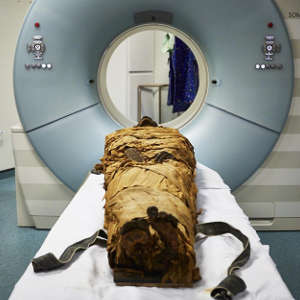Digital wellbeing should be a public health priority for the Arab region
21 October 2025
Published online 23 January 2020
Researchers aim to reproduce Nesyamun’s voice and transform museum visitor experiences.

Leeds Teaching Hospitals/Leeds Museums and Galleries
The model of the vocal structures of Nesyamun, who performed rituals at the Karnak temple complex during the reign of King Ramses XI (circa 1099-1068 BC), has so far only produced a single vowel sound.
Researchers who made the replica1 say the proof-of-concept could be developed through computer modelling to create whole sentences or songs to be played at museums.
A team led by electrical engineer David Howard, of Royal Holloway, University of London, performed a high resolution computed tomography (CT) scan on Nesyamun’s mummy. This confirmed the remains of his larynx and throat were largely intact. They measured the dimensions of the airway between Nesyamun’s lips and larynx, and then 3D printed a precise replica within a thin layer of plastic.
By attaching the replica vocal tract to an artificial larynx commonly used in speech synthesis, the group was able to produce a vowel sound somewhere between those in “bed” and “bad”.

Scientific Reports
In death, Nesyamun is lying on his back with his head tilted backwards, which is a position he is unlikely to have adopted when speaking. “We’re not saying that the vowel sound we have produced is one he would necessarily have used,” says Howard. “However, I’m confident it is accurate in that it is what we would hear from him in the position his body is in now.”
“The methodology used was accurate,” says Francesco Avanzini, a phoniatrician and ear, nose and throat specialist at the Bolzano General Hospital, Italy, who in 2016 helped synthesise2 vowel sounds from Ötzi the Iceman, a mummy dating back to around 5,300 years ago. “The final result is a little bit poor in order to evaluate the voice of Nesyamun, because we hear only a single vowel. It is, nevertheless, an interesting further attempt to investigate the voices of the past.”
The group now hopes to combine a computer model of Nesyamun’s vocal tract with knowledge of how human vocal components move during speech to create reproductions of speaking or singing based on the coffin hieroglyphs.
doi:10.1038/nmiddleeast.2020.11
Stay connected: